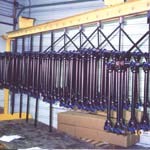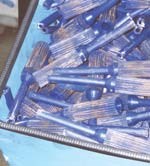Complex Parts, Innovative Solutions
When Valley Coatings Services was presented with the challenge of coating complex parts, the company explored new finishing technologies and worked with suppliers to develop custom solutions...
Valley Coatings Services, a division of Valley Design Enterprises (Fountain, MN), has been a provider of first-class job shop powder coatings since its inception in 1986. In addition to manufacturing and powdercoating table bases and office furniture, Valley coats components for customers in the automotive and recreational vehicle industries, chief among them, Neapco Inc.— a supplier of component parts for ATVs. It is this aspect of Valley's business that prompted the company to explore additional finishing technologies.
In researching new technologies, Valley had to consider a number of factors:
- Because automotive/ATVs components see a lot of exposure to the elements, it was important that they be able to offer a lot of corrosion resistance.
- The complexity of the parts would require the use of a coating with a low-enough viscosity to be able to penetrate deep recesses. The intricacy of some of the designs also meant that electrodeposition would not be an option, due to Faraday cage effect.
- At the same time, it was important that the selected coating have a low environmental impact (Minnesota employs some of the strictest environmental standards in the U.S.)
- Cost of implementing, operating and maintaining the new technology.
"Corrosion performance, environmental concerns, capital expenditure, coating versatility, and end use cost were all factors that went into choosing the best coating system for Valley Design," said Butch Isensee, Vice President of Valley Design.
After giving careful consideration to a number of different finishing technologies, Valley turned to autodeposition, a technology that has been around for nearly 30 years, but lacks the name recognition of powder coating or electrocoat. Autodeposition works by providing a non-electric driven organic coating reaction with the surface of ferrous metals. Paint films are formed by autodeposition of dispersed paint particles on steel, through a chemical reaction between paint and metal. The coating is supplied by means of a chemical reaction directly with the metal surface, so there is no need for a phosphate pretreatment stage and the other stages associated with the process. Because a coating will form on any steel surface that is wetted by the bath, excellent recess coverage and corrosion protection are obtained. Non-metallic components will not react, and no coating will form on these surfaces.
When it came time to select a supplier, Valley turned to EPSI Surface Technologies Group and its Autophoretic® 915 (ACC® 915) product. This is an epoxy-acrylic resin-based coating that builds on the family of autodeposition coating technologies. The epoxy product line, when coupled with a proprietary final rinse, provides a high level of corrosion protection, good thermal stability, topcoat ability and very low VOC, in a coating system that is heavy metal-free.
"Being a job shop, autodeposition provides us a flexible coating process that fits well with our customer needs. The ability to utilize ACC® 915 coating as a primer or stand-alone process makes us very diverse and competitive in our marketplace," said Mr. Isense.
Three automated hoists operate Valley's coating line. The tank alignment for the autodeposition line is as follows:
- Alkaline cleaning, immersion: 240 seconds
- Plant water rinsing, immersion: 120 seconds
- Acid pickling cleaning, immersion: 90 seconds
- Plant water rinsing, immersion: 45 seconds
- Alkaline immersion cleaning: 90 seconds
- Plant water rinsing, immersion: 90 seconds
- Deionized water rinsing, spray or immersion: 60 seconds
- Immersion in Autophoretic® autodeposition coating chemicals (ACC® 915): 120 seconds
- Plant water rinsing, immersion: 60 seconds
- Sealing water rinse, immersion: 60 seconds
- DI spray
- Oven curing
After emerging from the autodeposition sytem, the parts either proceed onto one of the powder coating operations or are removed as a finished good. (Autophoretic coatings have numerous automotive approvals and can be used as a sole coat or primer.)
Complex Parts, Innovative Solutions
The intricate design of the Neapco components posed some rather complex masking issues for EPSI. Since standard caps and plugs would not work with such complex parts, Valley turned to EPSI for a customized solution.
Dennis Clausen, Valley's Process Engineer, sent some of the components to EPSI to review. Upon receiving the parts, EPSI explored some concepts and delivered sketches of a proposed solution to Valley. The sketches, once approved, were used as the basis for prototype silicone plugs. After a successful test of the prototypes, a production order was put into place for the customized plugs. EPSI follows-up frequently with Valley in order to review the performance of the masking products. With each follow-up visit, EPSI and Valley look for ways in which they can improve the masking product further.
In developing the custom plugs, a number of issues had to be considered, requiring teamwork between supplier and end-user. Ergonomics, for example, is a critical factor. Line operators lack the time to struggle with the task of inserting and removing the plugs from the components, so EPSI designed the plugs to be able to be withdrawn from the part with little more than a quick tug of the wrist. Another issue lies in designing the plugs so that they won't be ripped apart by the sharp edges on many of the components being coated. And because silicone masking products gradually break-down with use over time, both parties had to work together to determine how many times the product could be reused.
According to Fred Schmidt, a Design Engineer for EPSI, the relationship has been mutually beneficial. "One of the reasons we enjoy working with Valley is that they are helping us learn about a brand new process," said Mr. Schmidt. "We need to work with these people and put our engineering resources at their disposal so that we can learn how to handle this new process (Autophoretic® 915)."
To learn more visit EPSI and Henkel Corporation.
Related Content
Surface Prep Solution for Rusted Rebar in Concrete
Julie Holmquist of Cortec Corporation discusses passivating corrosion on rebar and other reinforcing metals.
Read MoreIntumescent Coating Provides Up to 3 Hours of Fire Protection
PPG Steelguard 951 coating is designed to provide protection against fire and corrosion.
Read MoreProducts Finishing Reveals 2024 Qualifying Top Shops
PF reveals the qualifying shops in its annual Top Shops Benchmarking Survey — a program designed to offer shops insights into their overall performance in the industry.
Read MoreFinishing Systems Provider Celebrates 150 Years, Looks to Future
From humble beginnings as an Indiana-based tin shop, Koch Finishing Systems has evolved into one of the most trusted finishing equipment providers in the industry.
Read MoreRead Next
Episode 45: An Interview with Chandler Mancuso, MacDermid Envio Solutions
Chandler Mancuso, technical director with MacDermid Envio discusses updating your wastewater treatment system and implementing materials recycling solutions to increase efficiencies, control costs and reduce environmental impact.
Read MoreEducation Bringing Cleaning to Machining
Debuting new speakers and cleaning technology content during this half-day workshop co-located with IMTS 2024.
Read MoreA ‘Clean’ Agenda Offers Unique Presentations in Chicago
The 2024 Parts Cleaning Conference, co-located with the International Manufacturing Technology Show, includes presentations by several speakers who are new to the conference and topics that have not been covered in past editions of this event.
Read More


























